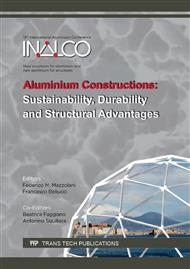[1]
Broetje Automation, EADS licenses its patented DeltaN friction-stir welding technology to BRÖTJE-Automation, http: /www. broetje-automation. de, (2012).
Google Scholar
[2]
A. von Strombeck, Rührreibschweißen von Hohlkammerprofilen, Lightweight Design 6, (2013) 44-47.
DOI: 10.1365/s35725-013-0222-8
Google Scholar
[3]
Information on https: /www. apple. com/imac/design.
Google Scholar
[4]
S. Hollunder, Lebensdauerabschätzung rührreibgeschweißter Aluminiumkonstruktionen; Clausthal-Zellerfeld, (2009).
Google Scholar
[5]
M. Pedemonte, C. Gambaro, E. Lertora, C. Mandolfino, Fatigue assessment of AA 8090 friction stir butt welds after surface finishing treatment, Aerospace Science and Technology 27 (2013) 188-192.
DOI: 10.1016/j.ast.2012.08.006
Google Scholar
[6]
S. Sheikhi, Herstellung und Bewertung der Umformbarkeit von reibrührgeschweißten Tailored Blanks aus Aluminiumlegierungen, GKSS Forschungszentrum Geesthacht GmbH, (2010).
Google Scholar
[7]
E. Lertora, C. Gambaro, C. Mandolfino, M. Pedemonte, Friction stir welding between extrusions and laminates, Welding International 29, (2015) 117-123.
DOI: 10.1080/09507116.2012.753309
Google Scholar
[8]
K. Anganan, J.G. Murali, M.M. Krishnan, K. Marimuthu, Study of Mechanical Properties and Experimental Comparison of Mig and Friction Stir Welding Processes for aa6082-t6 Aluminium alloy, IEEE 8th Proceedings International Conference on Intelligent Systems and Control (2014).
DOI: 10.1109/isco.2014.7103922
Google Scholar
[9]
C. Breivik, Mechanical Properties of Gas Metal Arc and Friction Stir AA6082-T6 Weldments, Norwegian University of Science and Technology, Trondheim, (2013).
Google Scholar
[10]
H.K. Mohammed, A comparative study between friction stir welding and metal inert gas welding of 2024-t4 aluminum alloy, ARPN Journal of Engineering and Applied Sciences 6 (2011), 36-40.
Google Scholar
[11]
M.K. Kulekci, E. Kaluç, A. Şık, O. Basturk, Experimental comparison of MIG and Friction Stir Welding processes for EN AW-6061-T6 (Al Mg1 Si Cu) aluminum alloy, The Arabian Journal for Science and Engineering 35 (2010) 321-330.
Google Scholar
[12]
J. Mononen, M. Sirén, H. Hänninen, Cost comparison of FSW and MIG welded aluminium panels, Welding in the World, Vol. 47 (2003) 32-35.
DOI: 10.1007/bf03266406
Google Scholar
[13]
Y.N. Zhang, X. Cao, S. Larose, P. Wanjara, Review of tools for friction stir welding and processing, Canadian Metallurgical Quarterly 51 (2012) 250-261.
DOI: 10.1179/1879139512y.0000000015
Google Scholar
[14]
S. Hirasawa, H. Badarinarayan, K. Okamoto, T. Tomimura, T. Kawanami, Analysis of effect of tool geometry on plastic flow during friction stir spot welding using particle method, Journal of Materials Processing Technology 11 (2010) 1455-1463.
DOI: 10.1016/j.jmatprotec.2010.04.003
Google Scholar
[15]
A. Arora, T. DebRoy, Toward optimum friction stir welding tool shoulder diameter, Scripta Materialia 64 (2011) 9–12.
DOI: 10.1016/j.scriptamat.2010.08.052
Google Scholar
[16]
R. Kumar, K. Singh, S. Pandey, Process forces and heat input as function of process parameters in AA5083 friction stir welds, Transactions of Nonferrous Metals Society of China 22 (2012) 288-298.
DOI: 10.1016/s1003-6326(11)61173-4
Google Scholar
[17]
C.D. Sorensen, A.L. Stahl, Experimental Measurements of Load Distributions on Friction Stir Weld Pin Tools, Metallurgical and Materials Transactions B 38 (2007) 451-459.
DOI: 10.1007/s11663-007-9041-6
Google Scholar


